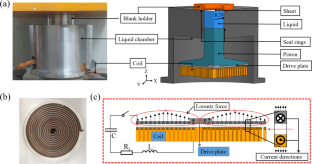During the high-speed forming processes, the metallic sheets are usually deformed under the biaxial tensile condition. The strain rate of metallic sheets often exceeds 102 s− 1. It is essential to determine the strain-rate-sensitive hardening model of metallic sheets for accurate numerical simulation of the high-speed forming processes. Thus, an electromagnetic hydraulic bulge experiment is proposed to determine the strain-rate-dependent hardening model of metallic sheets under the biaxial tensile condition with the strain rate of 102 s− 1. It is convenient to numerically simulate the electromagnetic hydraulic bulge processes. Hence, the strain-rate-dependent hardening models of metallic sheets can be determined by the inverse identification procedure of updating the numerical simulation. The electromagnetic hydraulic bulge experiments of SUS304 stainless steel sheet and AA5052-O aluminum alloy sheet were performed for the inverse identification of Johnson-Cook hardening model. The discrepancy between the experimental results and numerical simulation was minimized by optimizing the parameters of strain-rate-dependent hardening models. The dynamic flow stress curves of SUS304 stainless steel sheet and AA5052-O aluminum alloy sheet were higher than the static ones. However, the AA5052-O aluminum alloy sheet exhibits more significant strain-rate hardening effect than the SUS304 stainless steel sheet. The inverse identification of strain-rate-dependent hardening model of metallic sheet was validated by comparing the simulated and experimental results of electromagnetic micro-hydroforming of micro-channel.



